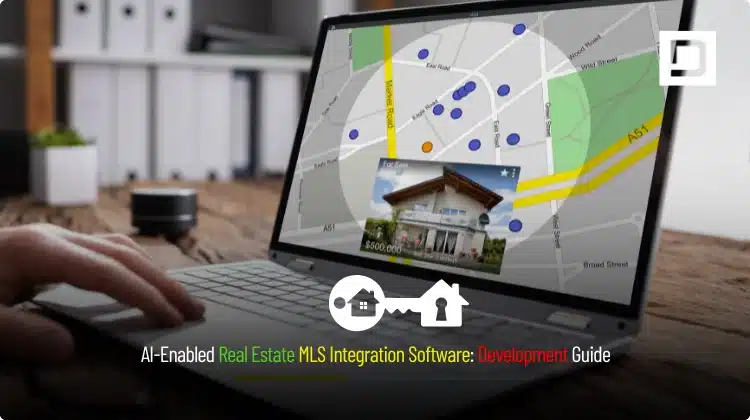AI-Enabled Real Estate MLS Integration Software: Development Guide
Real Estate MLS Software Development is no longer a “pull the feed and show the listings” exercise. Instead, modern platforms must ingest from multiple MLSs, normalize chaotic schemas, enrich the data with AI, and then deliver fast, compliant, and conversion-ready experiences across web and mobile. Consequently, teams that combine MLS standards with ai based Real Estate MLS solutions reduce time-to-value, increase lead quality, and improve broker productivity. Moreover, they scale into new markets without re-engineering core systems. This development guide explains, step by step, how to plan, architect, build, and continuously improve Real Estate MLS Development so your product ships quickly, stays compliant, and outperforms on search, discovery, and conversion.
Business outcomes first: decide what “winning” means
Before discussing schemas and tokens, define outcomes. Otherwise, scope and cost expand without direction. Therefore, clarify what you will measure and by when. For many brokerages, franchises, and proptech startups, the following goals anchor the plan:
- Reduce time-to-first-relevant-listing for buyers through semantic search and smart defaults.
- Increase lead-to-appointment conversion via timely alerts and better matching.
- Cut manual data cleanup, deduplication, and content rewriting with AI assistance.
- Improve agent productivity by surfacing pricing, comps, and “next best action” inside existing workflows.
- Build a durable data advantage by harmonizing fields across multiple MLSs and vendor feeds.
Because these outcomes are concrete, they shape sprint priorities, acceptance criteria, and launch sequencing.
Compliance foundations: standards, rights, and display rules
You cannot scale if you lose access. Consequently, design compliance into the product from day one. Most North American markets emphasize RESO standards, IDX/VOW rules, and attribution requirements. Although specifics vary by MLS, you should consistently handle:
- Data license management and renewal tracking.
- IDX versus VOW display differences (e.g., fields allowed, registration requirements).
- Proper attribution for listing agent, brokerage, and MLS.
- Media rights and mandatory photo credits.
- Auditable logs for how you transform, cache, and display data.
By treating compliance as a product feature rather than an afterthought, you minimize rework and, moreover, accelerate approvals for new markets.
Architecture overview: a composable, event-driven core
Great experiences are built on resilient plumbing. Therefore, adopt an event-driven, cloud-native architecture that separates ingestion, normalization, enrichment, and delivery:
- An ingestion layer that talks to RESO Web API, RETS (where still required), partner APIs, and SFTP bulk exports.
- A landing zone for raw snapshots and immutable logs, so you can replay transformations when upstream contracts change.
- A normalization layer that maps divergent MLS fields into a single property graph.
- A quality and validation service that applies rules and ML-assisted anomaly detection.
- An enrichment layer that adds embeddings, NLP summaries, image classification, neighborhood metrics, and pricing signals.
- A serving layer that unifies keyword, geo, and vector search and exposes clean Experience APIs (GraphQL/REST).
- Governance, security, and observability that keep data safe and systems debuggable.
Because this separation of concerns is explicit, teams can iterate on one layer without destabilizing the others.
Ingestion in practice: RESO, RETS, deltas, and backfills
Different MLSs offer different interfaces. Consequently, your connectors must be adaptable while still predictable:
- Prefer RESO Web API with OAuth 2.0 where available; however, support RETS if a market requires it.
- Implement incremental pulls using modified-since semantics, and, additionally, design reliable backfills for historical data.
- Respect rate limits, adopt exponential backoff, and surface lockouts immediately to on-call teams.
- Version every upstream schema so you can detect, explain, and remediate breaking changes quickly.
By blending frequent deltas for new or price-changed listings with slower enrichment cycles for heavier AI jobs, you keep the buyer experience fresh without exploding costs.
Normalization: make twenty MLSs read like one
Every MLS describes beds, baths, status, or property type slightly differently. Therefore, create a configurable mapping layer-expressed as data, not code-that aligns:
- Address formats, coordinates, and parcel identifiers.
- Property types, subtypes, and statuses.
- Measurements (imperial/metric), room counts, and floor levels.
- Feature taxonomies, amenities, and building descriptors.
- Media types: photos, floor plans, 3D tours, and videos.
Moreover, maintain a public-to-internal data dictionary. As a result, product, analytics, and ML teams can confidently build on the normalized model without chasing MLS-specific quirks.
Data quality: trustable listings or bust
Buyers abandon when data feels off. Consequently, pair rule-based validation with ML detection:
- Presence checks for essential fields such as price, beds, baths, coordinates, and status.
- Range checks for square footage, year built, and HOA dues.
- Cross-field consistency (for example, condos should include HOA fields).
- Media quality guards for minimum resolution, watermark detection, and count thresholds.
- Duplicate detection across MLSs, broker feeds, and re-syndication loops.
Additionally, publish dashboards that reveal systemic errors by MLS, field, or connector version. With these insights, you can fix root causes rather than patch symptoms.
AI enrichment: where the multiplier kicks in
Once the data is clean, AI transforms it into leverage. Because different teams value different capabilities, roll out enrichment in layers and measure impact as you go.
Semantic search and intelligent ranking
Convert listing text, room features, and user intent into embeddings. Next, combine vector search with keyword and geo filters. Then, re-rank results using a learning-to-rank model that considers freshness, price realism, image quality, and engagement. Consequently, buyers see better options sooner, and, moreover, they save and inquire more often.
Natural-language summaries and highlights
Turn structured fields and remarks into concise property summaries that emphasize layout, light, storage, schools, commute, and outdoor spaces. Additionally, keep an audit trail mapping each sentence to its source fields or rules so compliance reviews remain fast and reliable.
Image intelligence that boosts CTR
Classify rooms, choose the best cover photo, and flag non-compliant images automatically. As a result, cards look sharper, and, moreover, click-through rates rise without extra agent effort.
Pricing and comp signals
Start simple with comp selection and hedonic features; then, iteratively evolve toward AVM-style guidance. Meanwhile, expose pricing signals cautiously and clearly explain limitations to maintain trust.
Lead scoring and routing
Score leads on intent and recency while respecting privacy and consent. Subsequently, route them to the right agent by territory, price band, and availability. Therefore, follow-ups happen faster, and conversion improves.
Neighborhood and lifestyle layers
Enrich listings with school boundaries, transit access, walkability, air/noise indices, and amenity proximity. Consequently, filters feel more personal, and discovery becomes delightfully specific.
Front-end experience: fast, legible, and mobile-first
Delight begins at first scroll. Therefore, design for speed and clarity:
- Keep list and map perfectly synchronized; interactions should feel instant.
- Offer smart defaults for price, beds, baths, and type; then progressively reveal advanced filters.
- Let buyers save in plain language (“2-bed near the lakeside under ₹1.2 Cr”); the system translates to filters and alerts.
- Use photo-first cards with crisp facts and status pills; subsequently, lift CTR with quality images and relevant badges.
- Provide comparisons and shortlists that compute differences automatically (taxes, HOA, lot size, commute).
- Explain recommendations in a single, honest line to increase trust.
Because attention is scarce, reduce friction everywhere: skeleton loaders, optimistic saves, and clear confirmations keep momentum high.
Agent and broker workflows: give time back
Adoption rises when agents win hours back. Consequently, ship tools that compress routine work:
- Morning digests of price changes and new matches for active clients.
- Collaborative shortlists with comments, questions, and status markers.
- One-click marketing assets that remain compliant (flyers, open-house pages, and social snippets).
- Inline compliance helpers for media checks, disclaimers, and attribution reminders.
- A lead hub that surfaces intent scores and suggests the next best action.
Additionally, integrate these tools where agents already live-CRM, calendar, and email-so behavior change is minimal.
Integrations: CRM, messaging, showing tools, and partners
Your MLS platform should behave like a hub, not an island. Therefore, design clean interfaces:
- Two-way CRM sync for contacts, deals, and tasks, while preserving consent and opt-outs.
- Email and SMS alert pipelines with brand-safe templates and clear frequency controls.
- Calendar and showing integrations for instant booking and structured feedback.
- Ad platform connectors that build privacy-respecting audiences from first-party behavior.
- Mortgage and valuation partners that bring financing discussions into the flow, gently and helpfully.
Because integrations compound value, prioritize those that improve conversion or save agents time.
Security, privacy, and reliability: trust is the platform
Real estate data touches identities, finances, and homes. Consequently, treat security and reliability as must-haves:
- Enforce strong authentication, SSO, and MFA for staff tools.
- Encrypt data in transit and at rest; rotate secrets and audit access.
- Segment tenants for multi-broker deployments and minimize PII exposure.
- Snapshot databases and object stores; test restores regularly.
- Rate-limit Experience APIs and implement circuit breakers to prevent noisy neighbor effects.
- Centralize logs, metrics, and traces; additionally, alert on data drift and schema changes.
Moreover, publish a status page and transparent post-mortems. Trust grows when communication is clear, even during incidents.
Performance and scalability: speed is a feature
Search latency directly impacts engagement. Therefore, architect for low p95s:
- Decouple ingestion from serving with queues so bursts don’t block buyers.
- Update search indexes incrementally; enrich heavier features in micro-batches.
- Place caches close to users; then invalidate intelligently when listings change.
- Deploy blue/green or canary releases to avoid downtime during upgrades.
- Track hot queries and pre-compute expensive aggregations where sensible.
Because performance is visible and compounding, prioritize it in every sprint.
Data model design: a property graph that lasts
A stable data model keeps features moving. Consequently, center on these entities:
- Property with MLS identifiers, normalized fields, computed features, embeddings, and media links.
- Media with rights metadata, quality scores, room labels, and canonical URLs.
- Location with geometry, standardized addresses, and neighborhood overlays.
- Agent and brokerage with attribution and office details.
- User/lead with preferences, activity, and consent flags.
- Events for viewed, saved, shared, and tour-requested actions.
- Versioning and lineage to reconcile raw, normalized, and enriched states.
Because analytics and ML prefer clarity, mirror the normalized model into a columnar warehouse while the app uses document and vector stores for speed.
Testing and QA: prove that it works, every day
Quality is a habit, not a phase. Therefore, go beyond unit tests:
- Contract tests per MLS connector to catch upstream schema changes before they hit production.
- Golden datasets that validate mapping accuracy and enrichment stability.
- Synthetic traffic to stress pagination, geo filters, and mobile networks.
- Compliance scenarios that confirm IDX/VOW displays, attribution, and disclaimers.
- A/B experiments that verify conversion gains from AI features before broad rollout.
Additionally, automate checks in CI/CD so regressions are blocked early and visibly.
Analytics and KPIs: measure what matters
If you can’t measure it, you can’t improve it. Consequently, track metrics across the funnel:
- Discovery: time-to-first-click, time-to-first-save, and recommendation CTR.
- Quality: duplicate suppression, missing-field rates, and image quality distributions.
- Conversion: lead-to-appointment, appointment-to-offer, and offer-to-close by segment.
- Operations: hours saved in cleanup and percentage of AI summaries accepted as-is.
- Compliance: incidents per month and mean time to resolution.
Because these metrics tie to revenue and cost, they help prioritize the roadmap credibly.
Project plan: phased delivery that de-risks complexity
Ambition is good; sequencing is better. Therefore, roll out in three phases.
Phase 0: Discovery and compliance readiness
Interview stakeholders, gather MLS requirements, and draft the initial data dictionary. Simultaneously, document IDX/VOW rules and define the key outcomes you will measure. As a result, the team aligns on what to build first.
Phase 1: Foundation and first market
Implement the first connector, storage, normalization, and Experience APIs. Launch a minimal but fast search + map interface. Validate compliance with real listings. Consequently, buyers start finding relevant homes, and agents begin to trust the platform.
Phase 2: AI enrichment and adoption levers
Introduce embeddings, hybrid search, NLP summaries, duplicate detection, and photo quality selection. Meanwhile, integrate CRM and messaging for alerts and follow-ups. Then, run experiments that verify improvements in time-to-first-save and lead conversion. Subsequently, scale to additional MLSs using configuration, not code.
Because value arrives steadily in each phase, stakeholders stay engaged and, moreover, budgets stay rational.
Technology choices: pragmatic, portable, and proven
There is no single “correct” stack; however, several patterns work reliably:
- Connectors that abstract RESO/RETS and vendor APIs behind a common interface.
- Pipelines that mix streaming for deltas with scheduled micro-batches for enrichment.
- Storage that separates raw snapshots, normalized relational entities, document detail records, and vector indexes.
- Search that blends keyword, geo, and vectors, followed by a learned re-ranker.
- ML that favors maintainability: embeddings for text/images, transformers for summaries, and tree/linear models for scoring.
- Front ends that are mobile-first, map-aware, and instrumented for analytics.
- Observability that treats data drift and schema mismatch as first-class signals.
Because each choice balances speed, cost, and portability, revisit them quarterly as traffic and markets evolve.
SEO for an AI-first world: be clear, fast, and fresh
Search engines increasingly summarize, answer, and recommend. Consequently, your content must be clean, current, and helpful:
- Structure listing pages with normalized facts, semantic summaries, and contextual comparisons.
- Keep TTFB low, compress images responsibly, and serve at the edge where possible.
- Update sitemaps and timestamps as listings change so freshness signals remain accurate.
- Write descriptive titles and slugs that reflect neighborhoods and property types.
- Display trust cues such as attribution, broker verification, and clear contact pathways.
- Distribute to owned channels-email and social-with UTMs so you learn what truly works.
Because helpful pages earn links and mentions, rankings follow without resorting to gimmicks.
Governance and ethics: transparent AI by design
AI should inform, not mislead. Therefore, build responsible defaults:
- Explain why a listing was recommended (“matches budget, commute, and outdoor preferences”).
- Label generated copy when policy requires and, additionally, allow quick human edits.
- Avoid targeting or filtering on protected attributes; instead, personalize on behavior and stated preferences.
- Honor takedowns quickly; propagate deletions across caches and indices.
- Store prompts, outputs, and lineage for auditing, rollback, and training hygiene.
Because trust compounds, responsible practices pay off in retention and referrals.
Budget and resourcing: invest where leverage is highest
Costs depend on markets, MLS count, and feature depth. Nevertheless, a few patterns hold:
- Upfront work concentrates in ingestion, normalization, and the first search experience.
- AI enrichment can be layered in after launch and, importantly, paid for by measured conversion gains.
- Cloud spend is manageable when enrichment runs in micro-batches and caches are tuned.
- Ongoing costs include new MLS onboarding, compliance upkeep, and UX polish.
Consequently, tie spend to milestones that demonstrate buyer and agent value, not just infrastructure completeness.

Implementation checklist: ship confidently
Because checklists reduce mistakes, use one:
- MLS agreements signed; IDX/VOW requirements documented and reviewed.
- Data dictionary finalized; mappings implemented as configuration.
- Ingestion connector deployed with deltas, backfills, and rate-limit safeguards.
- Validation and duplicate detection live; quality dashboards visible to ops.
- Hybrid search online with target p95 latencies met.
- NLP summaries gated behind feature flags; audit trails in place.
- Compliance displays verified by an internal reviewer and, where required, the MLS.
- Analytics dashboard tracking discovery, quality, and conversion.
- Incident playbooks drafted for connector outages, schema shifts, and cache invalidation.
- Roadmap approved for the next MLS and the next two AI enhancements.
Because this list is explicit, teams align quickly and handoffs become routine rather than risky.
Frequently asked questions on Real Estate MLS Software Development
How fast can we reach first value?
With one MLS and a focused scope, teams often launch a fast, compliant search + map in 10–14 weeks. Subsequently, AI enrichment ships over the next 6–10 weeks and, moreover, is validated by A/B tests.
Do we need a full AVM to start?
No. Instead, begin with comp selection and lightweight pricing signals. Then graduate toward AVM-style guidance as your dataset and confidence grow.
Will AI summaries create compliance risk?
They don’t have to. Because you ground copy in structured fields and maintain a sentence-to-source lineage, reviewers can approve quickly and, additionally, disable generation per listing when necessary.
How painful is multi-MLS scaling?
It’s manageable if normalization is configuration-driven. Consequently, each new MLS becomes a mapping exercise, not a rewrite.
Can agents opt out of certain AI features?
Yes. Provide per-brokerage controls and, furthermore, show usage analytics so leaders choose based on data, not anecdotes.
Why Depex Technologies: speed, safety, and measurable lift
Depex delivers Real Estate MLS Development with a pod that blends product, data, engineering, ML, UX, compliance, and SRE. Because we prioritize outcomes, we sequence work so you see conversion gains early rather than waiting for an all-or-nothing reveal. Moreover, we build with RESO-aligned ingestion, rigorous normalization, and responsible AI, so your platform remains both fast and trustworthy as you expand.
- We set up connectors and deltas that stay healthy under load.
- We normalize and deduplicate so product teams ship confidently.
- We deploy embeddings, ranking, and summaries that buyers feel immediately.
- We design map-first experiences that look sharp and load instantly on mobile.
- We implement security, observability, and disaster recovery from day one.
Consequently, you get a robust platform, a credible roadmap, and a measurable advantage in your market.
Conclusion: turn listings into intelligence-and intelligence into closings
An MLS feed is raw material. A well-designed platform transforms it into discovery, trust, and action. Therefore, when you combine clean ingestion, thoughtful normalization, and ai based Real Estate MLS solutions, you deliver a search experience buyers prefer and a workflow agents adopt. As a result, your brand grows by delighting users rather than out-shouting competitors.

If you’re ready to evaluate your current stack, select the right standards, and design an AI-enabled rollout that fits your budget and timeline, then Depex Technologies can help. Furthermore, we’ll guide you from assessment to launch-and subsequently through optimization-so every sprint moves metrics that matter.






